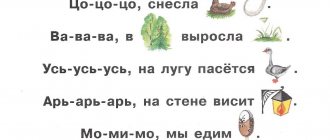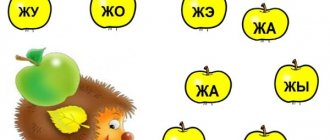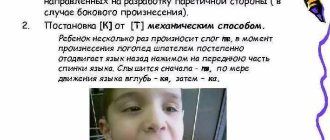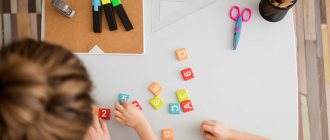MAGAZINE Preschooler.RF
“Didactic exercises using pure proverbs to automate the sounds “S”, “S” during individual lessons with children with mental retardation”Speech therapist teacher: Yana Petrovna Loskutova MBDOU No. 12 “Ladushka”, Tikhoretsk
To automate the sounds “С” and “Сь”, we suggest using tasks with pure words that children with mental retardation like.
Pure talk is a small genre of folklore; a folk-poetic joke consisting of a deliberate selection of words that are difficult for correct articulation during rapid and repeated repetition, constructed in such a way that in the first part the same syllable is most often repeated three or more times, and the second part is 3 - 4 words that rhyme with the first part. Also K.I. Chukovsky, noted in his study “From Two to Five” that children have a special need for the rhyming of the words they pronounce; they are inherently attracted to rhyming sounds. And the smaller the child, the worse his command of speech, the more he gravitates towards rhyme. Thanks to rhyme, words attract the child's special attention.
Since rhymed speech is based on the rhythmic pronunciation of sounds, rhythm is the basis of the child’s selective attitude towards rhyme. The rhythm closest to this phenomenon is the beating of the heart, which, as is known, is an innate biorhythm; therefore, it can be assumed that the tendency of children to perceive a similar external rhythm, which is rhymed speech, is an innate quality. In other words, the key is the fact that children are attracted to rhyming sounds, i.e. children's direct interest in reproducing speech forms, which allows the speech therapist to work successfully in a given direction.
Pure sayings find an emotional response in the child’s soul, make the material to be studied fascinating and interesting (and what is done without interest is not remembered or is remembered with difficulty);
- help simultaneously with speech tasks to solve problems of mental, mental and moral education
- help to effectively solve new tasks in the sound culture of speech in an interesting way
- help to spend an emotional physical training session, provide an opportunity to relieve tension
Pure tongues, as rhythmically organized speech, activate the child’s entire body, contribute to the development of his vocal apparatus, and reinforce the correct pronunciation of sounds.
Pure phrases contribute to:
- improving sound pronunciation
- improving fine motor skills
- improving the syllabic structure of words
- improving speech breathing
- development of speech tempo
- development of voice power
- formation of a sense of rhythm
At the first stage, the main goal of the teacher is to develop correct speech perception and auditory attention. That is, we simply show a card with a picture and clearly pronounce the phrase. Then you can discuss the content of the picture a little, but at the end you can return to reading the whole story. There is no need to immediately give your child a mountain of cards.
You need to learn pure phrases gradually. You can show a new card with a clear phrase in class. Then you can give it to the group of teachers, where in the evening you can look at it again, talk about it and consolidate it. And in the evening you can give it to your parents to repeat it with your child before going to bed.
The presentation of speech material in pure tongues can occur in various ways:
- Absolutely any pure saying can be sung. Children especially enjoy singing and pretending to be famous animals. There are also a lot of options here: for example, like a bear (in a rough voice), or like a fox (cunningly and slyly), or like a mouse (in a squeaky voice), or like a kitten (affectionately and tenderly), etc. It is important to give children the opportunity to decide for themselves which animal they will portray next.
- Staging. This technique is very popular with children, but it should be remembered that not all pure sayings can be “showed” or staged. Therefore, it is necessary to think through everything in advance and select the suitable ones. Children can show a pure tongue all at once, at the same time, and at this time the teacher pronounces the words, watches the children and chooses the one who is especially diligent. Or another option - one child acts as an actor, showing a dramatization, and the rest of the children (they are also spectators) loudly, in chorus, pronounce a pure speech. Moreover, each child should take turns playing the role of an actor. Consequently, the pure speech will be pronounced at least as many times as there are children in the group. This technique, like the previous one, liberates children and reveals their acting abilities.
- Answer the question. Working in this vein implies that a pure tongue can not only be an excellent exercise for strengthening the articulatory apparatus, but also serve as rich material for a preschooler’s numerous thoughts: what (who) is this pure tongue talking about? Does this really happen? Why? How many words are there in a sentence? What word do you not understand? Which sound is most common here? How can you describe this sound?
It is important to listen to everyone who wants to speak. Answers - reasoning to such questions develops children's thinking, teaches them to put forward hypotheses, enrich their vocabulary, teaches them to distinguish the sounds of speech by ear, helps them master the sound analysis of words, preparing them for mastering school literacy.
4. Dialogue. Two people participate in pronouncing a pure phrase, and a dialogue takes place between them. It is important that children strive to pronounce the phrase as clearly and as best as possible, while emotionally playing the role planned for the situation (yard grandmothers - gossips, long-time friends, animals, and others).
5. Mirror. One child in a pair portrays a person standing in front of a mirror, and he must pronounce clearly, opening his mouth wide and clearly pronouncing each sound; the second child stands face to face with the first and portrays a mirror, or rather, a mirror reflection. His task is to silently, with just his lips, accurately repeat the text. Then you should switch roles.
For this technique, which perfectly develops the attention of preschoolers, any pure saying is suitable, as long as it is interesting to children.
6. Audio repeat. The speech is recorded on a tape recorder. The teacher decides how many times and at what tempo words and sentences will be spoken. The child’s task is to repeat the reproduced text. You can record your child's voice on a tape recorder. Hearing yourself from the outside will not only be entertaining, but also useful.
7. Illustration. This method is also called “Sketching” . It is better to use it as homework. Children write down the learned phrases on a separate sheet of paper and make an illustration for them. It does not matter whether the child has the ability for visual arts or not. Each child draws as best he can, and the help of mothers, fathers, grandmothers, grandfathers, brothers and sisters is only welcome. Thus, after a series of lessons, the children form their own book with pure sayings. This technique develops imagination and gives endless scope for creativity.
Pure sayings are fun to say in different moods: cheerfully, sadly, with kindness, with anger, with tenderness and affection, and at different paces - quickly - slowly... Having mastered the pure saying, you can move on to the next one.
To work in individual lessons, we use the following games and exercises with pure phrasing to automate the sound “C” :
1. Didactic exercise “Loud, quiet, whispering” .
Assignment for the child: Say a clean talk loudly, quietly, in a whisper: roar the clean talk like a bear; squeak like a mouse, etc.
2. Didactic exercise “Say a word”
Assignment to the child: The teacher says “Ry-ry-ry, I’m carrying...” (the child answers “balls” ), you show him the card and rejoice at his success. Then encourage him to pronounce the first syllables of the pure phrase, then the entire pure phrase.
3. Didactic exercise “Slow-fast” .
Task for the child: Pronounce the phrase slowly and quickly
4. Didactic exercise “Which one, which one, which one?”
Task for the child: Answer questions in the form of pure phrases. For example, we take a card that is familiar to the child, one that we have learned. And I start asking pure questions: “What kind of braid is that?” “Sa-sa-sa, who has a braid?” . You also need to answer honestly. (the child answers “Sa-sa-sa is a sharp scythe. So-so-so what wheel? So-so-so whose wheel is this?”)
5. Didactic exercise “One-many” based on pictures (sa-sa-fox, sy-sy-foxes, is-is-many foxes).
6. Didactic exercise “Say the opposite” (sa-sa-sa - long braid; sa-sa-sa - short braid)
7. Didactic exercise “What’s missing?” (sa-sa-sa the wheel is gone, sy-sa-sa the sausage is gone)
8. Didactic exercise “Make an interesting story” based on the picture is-is-is-a-fox? What kind of fox? Sa-sa what is the fox doing? Who did the fox meet? So-so-so- the car has a wheel. So-so-so-the wheel fell off. So-so-so-they changed the wheel. So-so-so-owl sat on the wheel.
9. Didactic exercise “Don’t make a mistake” The child needs to choose a word for a certain syllable. Ra-rocket, ra-pyramid, ra-guitar.
10. Didactic exercise “Carousel” The child spins the disks and matches the picture to a certain syllable.
11. Didactic exercise on agreeing adjectives with nouns in pure proverbs.
Task for the child: finish and write the ending:
ca-sa-sa, sa-sa-sa Oh-oh-oh! The wasp is flying! sy-sy-sy, sy-sy-sy...
12. Didactic exercise “Sound engineer on the radio”
Assignment for the child: before the program goes on air, the sound engineer checks whether all the equipment accurately conveys the text, and to check it, he speaks through headphones into the microphone (for this you need large headphones and a children's microphone);
13. Didactic exercise “Mirror”
Assignment for the child: First, the child, paired with an adult, portrays a person standing in front of the mirror, and he must pronounce clearly, opening his mouth wide and clearly pronouncing each sound; the second child stands face to face with the first and portrays a mirror, or rather, a mirror reflection. His task is to silently, with just his lips, accurately repeat the text. Then you should switch roles.
For this technique, which perfectly develops the attention of preschoolers, any pure saying is suitable, as long as it is interesting to children.
14. Didactic exercise “Let’s talk” (exercise in the form of a dialogue). Two people participate in pronouncing a pure phrase, and a dialogue takes place between them. It is important that children strive to pronounce the phrase as clearly and as best as possible, while emotionally playing the role planned for the situation (yard grandmothers - gossips, long-time friends, animals, and others).
15. Didactic exercise “An artist before going on stage”
Assignment for the child: You need to sing a clear phrase for the singer to sing before going on stage. There are also a lot of options here: in a rough voice, cunningly and slyly, in a squeaky voice, affectionately and tenderly and at different pitches, etc.
Conclusion
The use of these techniques provides the child with the opportunity to create “his own” , to come up with it himself. But another important action in this case is the creation of a problem situation that activates the child’s imagination, word creation, inventing rhymes, and forms language abilities.
A pure talker, like a rhyming phrase with frequently repeated sounds, arouses children’s interest in speech therapy classes. But you should not repeat the same phrase for a long time, this may bore the child and valuable interest will be lost. It is better to take several phrases or poems of pure words at once and practice them at the same time.
Games with pure sayings are fun and active, and very often awaken the imagination of children and adults to come up with their own pure sayings. After all, they don’t have to have meaning; they can be absolutely abstract and even meaningless lines or poems. Their main purpose is to produce sound.
Thus, in order to form pure speech in a child, it does not matter at all whether you use original or well-known pure speech. The main thing is to use them and do it systematically!
The proposed didactic material is easily reproducible and can be used by both speech therapists and educators for the development of sound culture and word creation in preschool children.
Application
Sound “S” Pure sayings for automating the sound “S”.
| 1 | Sa-sa-sa - the fox is running. Sa-sa-sa - here comes the wasp. Sa-sa-sa - there is a wasp in the garden. Sa-sa-sa - the dew fell. Sa-sa-sa - a wasp flew to us. Sa-sa-sa - pine forests. |
| 2 | Su-su-su - berries in the forest. Su-su-su - I’m bringing lunch to the table. Su-su-su - they saw a fox in the forest. Su-su-su - we saw a wasp. Su-su-su - braid your hair. Su-su-su - it was cold in the forest. |
| 3 | Sy-sy-sy - we are not afraid of wasps. Sy-sy-sy - Sanya has beads. Sy-sy-sy - the catfish has a mustache. Sy-sy-sy - the clock is ticking. Sy-sy-sy - they gave me scales. |
| 4 | So-so-so- the car has a wheel So-so-so-the wheel fell off So-so-so-changed the wheel So-so-so-owl sat on the wheel |
| 5 | Sonya's us-us-us cactus Us-us-us-Sani has a new bus Us-us-us-what a bite Us-us-us-Svetlana has a lot of beads |
| 6 | Os-os-os-I'm carrying a big tray Wasps-os-os-there are a lot of wasps in the clearing Os-os-os-I have a new pump Os-os-os-my son's nose |
| 7 | As-as-as-we have kvass at home As-as-as-I have pineapple As-as-as-bed the big palace As-as-as-Sanya peels a pineapple |
| 8 | Is-is-is-pussy let's call kitty-kis Is-is-is-we will plant cypress Denis eats is-is-pineapples Is-is-is-I eat rice |
| 9 | Ys-ys-ys-Sonya drinks kumiss Ys-ys-ys-by the river cape Us-us-us-we are bringing home a watermelon Us-us-us-sweet pineapple tastes |
| 10 | Sa-sa-sa - sleigh, garden, wasp. Sa-sa-sa- scooter, owl, fox. Sy-sy-sy - braids, hair, mustache. So-so-so - soda, sable, wheel. Su-su-su - soup, dishes, blue whiting. |
| The sound "Сь" Pure sayings for automating the sound "Сь". | |
| 1 | Xia-xia-xia - we caught a crucian carp. Siu-siu-siu - Sonya ate all the porridge. Se-se-se - everyone sat down on the bench. Xia-Xia-Xia—Lucy is coming towards us. |
| 2 | Xia-xia-xia - the goose's paws are red. Si-si-si - white geese. Si-si-si - don’t carry water in a sieve. |
| 3 | Syu-syu-syu - Sima ate all the porridge. Si-si-si - a taxi arrived. Xia-xia-xia - grandma has two geese. |
| 4 | Se-se-se - ribbons in the braid. Si-si-si - cut some hay. Si-si-si - bring it here. Xia-Xia-Xia - Vasya is a fidget. |
| 5 | Xia-Xia-Xia - near the aspen Asya. Si-si-si - grandma has geese. Si-si-si - a letter from Musya. Hurry up, we'll finish the entire construction. |
| 6 | Se-se-se - we will come to visit the fox. As-as-as - the crucian carp is swimming. Us-us-us - a goose is walking in the meadow. Axis-axis-axis - an elk was walking through the forest in winter. |
| 7 | Us-us-us - I’m very afraid of geese. As-as-as - I found a notebook. Us-us-us - grandma has a gray goose. As-as-as - a crucian carp is swimming in the river. |
| 8 | Ys-ys-ys - a lynx lives in the forest. Us-us-us - a goose comes out of the river. Axis-axis-axis - well, throw the ball. |
| 9 | Axis-axis-axis - there is an elk in the clearing. Us-us-us - a goose is approaching us. Usi-usi-usi - grandma's geese. Sed-sed-sed - we have a new neighbor. |
| 10 | Sen-sen-sen - spring and autumn. Sil-sil-sil - Vasya was mowing the grass. He sat down, sat down, and a donkey was coming towards us. Sin-sing-sing - we shared an orange. |
| 11 | Sil-sil-sil - the cat bit Sema. This, this, this - sow flour. Syata-syata-syata - the fox has cubs. Seed-seed-seed - blue ribbon. |
| < Previous | Next > |
Automating the C sound in words
1. Oh, the entryway, the entryway, sleepy Senya came out into the entryway, and in the entryway Senya stumbled and somersaulted through the vice. 2. It was fun on the slide for Sana, Sonya and Yegorka, but Marusya didn’t ride - she was afraid to fall into the snow. 3. Stepan has sour cream, curdled milk and cottage cheese, seven kopecks - a tuesok (a birch bark jar with a tight lid and a bracket or bow in it). 4. Sanya is taking his sleigh up the hill. 5. We sat down in seven sleighs, seven to a sleigh. Sanya was driving down the hill, and Sanya was riding a sleigh. 6. There are dryers for Prosha, Vasyusha and Antosha. Two more dryings for Nyusha and Petrusha. 7. Grandma bought beads for Marusya, but at the market the granny tripped over a goose. All the beads were pecked by the geese. 8. Sasha loves sushi, Sonya loves cheesecakes. 9. Sasha walked along the highway and sucked on a dryer. 10. Sasha walked along the highway, carried a dryer on a pole, and sucked on the dryer. 11. Senya was carrying a cart of hay. 12. Senya and Sanya have a catfish with a mustache in their nets. 13. Senka is carrying Sanka and Sonya on a sled; Sleigh jump - off Senka's feet, Sanka's side, Sonya's forehead. 14. Kostya mows hay for Senya, Senya carries hay in the canopy. 15. Senya carries hay in the canopy; Senya will sleep on the hay. 16. Elephants are smart, elephants are meek, elephants are calm and strong. 17. Titmouse, titmouse - sister to the sparrow. 18. The bridge of the nose does not move from nose to nose. 19. There’s a tit on the knitting needle, the tit can’t sleep. 20. Senya, Seryozha and Sasha have soot on their noses, necks, ears and cheeks (f, s, w, sch) 21. Grishka asks Sasha: “Does the swift have a wife with a haircut?” (f, s, w). 22. There is forty forty on the nose of a rhinoceros. 23. Raisa has a sister Larisa, Larisa has a sister Raisa. 24. Tosya, don’t carry soda in the sieve. 25. The badger carried the dry branch. 26. Have fun, Savely, stir the hay. 27. The wasp does not have whiskers, not whiskers, but antennae. 28. Osa is barefoot and without a belt. 29. Slava ate lard, but there was not enough lard. 30. The post on the pavement is empty - Senya the guard is on strike. 31. Styopa brought colorful sparkles to the sisters at the crossroads. 32. Alesya sat down, her legs hanging off the stove, don’t laugh, Alesya, but warm yourself on the stove. 33. Anos took him to sow oats. I sowed oats. The oats are born. Anos came, cut the oats, tied the oats, threshed the oats, Anos picked the oats down to the grain, took away a cartload of oats. 34. The birch is rooty, crooked at the root, gnarled at the middle, and tall at the top. 35. A goat walks with a side-eyed goat, a goat walks with a barefoot goat (k, s). 36. A scythe-goat walked with a scythe; a scythe goat came with a scythe (k, s). 37. Does not want to mow with a scythe; says: “Scythe braid” (k, s). 38. Mower Kasyan mows obliquely. Kasyan the mower will not mow. 39. The scythe hare sits behind the sedge-grass, looks with a scythe, as a girl with a scythe mows the grass with a scythe. 40. The mower mowed, carried a scythe. Mow, scythe, while there is dew, away with the dew - mow home. The scythe mows smoothly, the scythe loves the spatula, the spatula is sand, the scythe is a pie. 41. Vasya mowed ripe oats with a mower. 42. In the field, the flight of millet fields, Frosya takes out the weeds (I. Demyanov). 43. The chicken is bright and colorful, the duck is flat on its toe. 44. Ruff, gudgeon, sturgeon, stellate sturgeon are happy to meet each other. Sukhina E.I. 45. Sysoy has a mustache from his nose to his waist. 46. Father-in-law has a nose and mustache in dough. 47. A stay-at-home neighbor has a restless neighbor, a restless neighbor has a stay-at-home neighbor. 48. The daughter-in-law scurries from sheaf to sheaf. 49. Not all Lenas in the universe are cheerful. 50. Don’t sit on a pug dog - it will bite.
New pure sayings.
Pure sayings starting with the letter “A”.
Authors: V. Lunin, V. Borisov, I. Mazin, O. Krasnorutsky, M. Yasnov.
The sunset is falling behind the forest. Scarlet storks are flying to the forest. The asters began to glow in the flower beds in the garden, the water lilies in the pond became scarlet, the scarlet ducks glide across the pond... It’s a pity that the sunset is already dying out!
The alligator received the alphabet. The alligator learned the alphabet, the alligator absorbed knowledge, and then swallowed the alphabet.
Arab Abu said to the slave: “Ali, drive the arba to Rabat.” But slave Ali was deaf, so he drove the arba to Arbat.
And here we have pineapple, And here we have watermelon, And here in the Altai mountains we have Cherry plums, made to order...
And here in Arabia, every hour there are accidents: Either a camel pushes a ram, or a ram hits a monitor lizard...
The house ran, Everyone said: - Bus! The house flew away. Everyone shouts: “Airbus!”
Aty-bats, acrobats They ran out of the gate - Aty-bats, bearded, Aty-bats, without beards. Aty-baty, in half a minute they climbed onto the trampolines. The acrobat pushed the sloping mat towards the acrobat. On trampolines, aty-baty, acrobats tumbled. They jumped on the mats together and did the splits!
Pure sayings starting with the letter “B”.
Authors: P. Sinyavsky, E. Izmailov, V. Lifshits, G. Vardenta, M. Shvarts, A. Kostakov, M. Yasnov, P. Matveeva, I. Demyanov, T. Belozerov.
Alyonka had a lapdog, Alyonka had a lapdog. Alyonka was walking with a lap dog, Bolonka was walking with Alyonka.
White snow, white chalk, White sugar is also white. But the squirrel is not white, it wasn’t even white.
Beavers live in our river. Beavers are cheerful, beavers are kind. Mudras - dam builders - Beavers - river inhabitants.
Brother beavers, please, cut down and hollow out a booth from an oak tree, a pipe from a beech tree!
A beaver wanders with a log, the log crushes the beaver’s sides...
A bull was walking down the street. Looks: a trash can! Where should the bull go? The bull turned the tank over: Then he lay down on the barrel: The bull lies on the barrel - The tank lies on the bull.
- Here's a bud. And here is the can. Here's a can. And here is the python. A loaf of bread is baked in the oven. And there is a bud in the buttonhole. A python is crawling through the grass, and there is concrete at a construction site. Repeat in my tone: Where is the bud, and where is the loaf, Where is the can, and where is the python, Well, where is the concrete. - One-two-three-four-five, I begin to repeat: A bud is baked in the oven, And a loaf is put into the buttonhole, A can is crawling along the grass, Milk is flowing into the concrete, And there is a python at a construction site. - No not like this! No not like this! Tell me yourself: how? Figure it out for yourself, Where is the bud and where is the loaf, Where is the can and where is the python, Well, where is the concrete.





